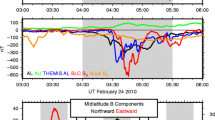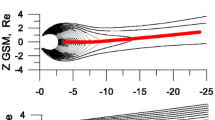Abstract
Two substorms occurred at ∼04:05 and ∼04:55 UT on February 26, 2008 are studied with the in-situ observations of THEMIS satellites and ground-based aurora and magnetic field measurements. Angelopoulos et al. have made a comprehensive study of the 04:55 UT event. We showed detailed features of the two substorms with much attention to the first event and to the relationship between mid-tail magnetic reconnection (MR) and substorm activities. It was found that in the earlier stage of each substorm, a first auroral intensification occurred 2–3 min soon after the start of mid-tail MR, followed by a slow and very limited expansion. The auroral arcs were weak, short-lived, and localized, characterizing all features of a pseudobreakup. We regarded the first auroral brightening as the initial onset of the substorms. A few minutes later, a second stronger auroral intensification appeared, followed by quick and extensive expansions. It was interesting to note that the second brightening and related poleward expansion happened almost simultaneously (within a couple of minutes) with the onset of earthward flow and dipolarization in the near-Earth tail and other phenomenon of the substorm expansion phase. We thus regarded the second auroral brightening as the major onset of the substorms. Furthermore, it was seen that during the growth phase of the two substorms, the polar cap open flux Ψ kept increasing, while it quickly reduced during the substorm expansion and recovery phase. These variations of Ψ implied that the evolution of the two substorm expansion phases were closely related to MR of tail lobe open field lines. Analysis of substorm activities revealed that the two events studied were small substorms; while estimate of MR rate indicated that the MR processes in the two substorms were weak. The aforementioned observations suggested that mid-tail MR initiated the pseudobreakup first; the earthward flow generated by MR transported magnetic flux and energy to the near-Earth tail to cause the formation of SCW and CD, which induced near-Earth dipolarization and major auroral brightening, and eventually led to the onset of the substorm expansion phase. These results were clearly consistent with the picture of NENL and RCS models and supported the two step initiation scenario of substorms.
Similar content being viewed by others
References
Lui A T. Current disruption in the Earth’s magnetosphere: Observations and models. J Geophys Res, 1996, 101(A6): 13067–13088
Mcpherron R L. Physical processes producing magnetospheric substorms and magnetic storms. Geomagn, 1991, 4: 593–739
Baker D N, Pulkkinen T I, Angelopoulos V, et al. Neutral line model of substorms: Past results and present view. J Geophys Res, 1996, 101: 12975–12987
Baumjohann W. Modes of convection in the magnetotail. Phys Plasmas, 2002, 9(9): 3665–3667
Lui A T, Mankofsky A, Chang C L, et al. A current disruption mechanism in the neutral sheet—A possible trigger for substorm expansions. Geophys Res Lett, 1990, 17: 745–748
Pu Z Y, Kang K B, Korth A, et al. Ballooning instability in the presence of a plasma flow: A synthesis of tail reconnection and current disruption models for the initiation of substorms. J Geophys Res, 1999, 104(A5): 10235–10248
Pu Z Y, Korth A, Chen Z X, et al. A global synthesis model of dipolarization at substorm expansion onset. J Atmos Sol-Terr Phy, 2001, 63(7): 671–681
Zhang H, Pu Z Y, Cao X, et al. TC-1 observations of flux pileup and dipolarization-associated expansion in the near-Earth magnetotail during substorms. Geophys Res Lett, 2007, 34(3): L3104
Nakamura R, Baker D N, Yamamoto T, et al. Particle and field signatures during pseudobreakup and major expansion onset. J Geophys Res, 1994, 99(A1): 207–221
Mishin V M, Saifudinova T, Bazarzhapov A, et al. Two distinct substorm onsets. J Geophys Res, 2001, 106(A7): 13105–13118
Baker D N, Peterson W K, Eriksson S, et al. Timing of magnetic reconnection initiation during a global magnetospheric substorm onset. Geophys Res Lett, 2002, 29(24): 41–43
McPherron R L. Substorms, in COSPAR workshop on capacity development. http://www.faculty.iu-bremen.de/jvogt/cospar/cbw3/sub-storms/lecture_rmcpherron.pdf
Cao X, Pu Z Y, Zhang H, et al. Multispacecraft and ground-based observations of substorm timing and activations: Two case studies. J Geophys Res, 2008, 113
Angelopoulos V. The THEMIS mission. Space Sci Rev, 2008, 141: 5–34
Angelopoulos V, McFadden J P, Larson D, et al. Tail reconnection triggering substorm onset. Science, 2008, 321: 931–935
Lui A T. Re-evaluation of observations for the February 26, 2008 substorm reported to show tail reconnection triggering substorm expansion onset. Eos Trans AGU, 2008, 89(53): 1–5
Mcfadden J P, Carlson C W, Larson D, et al. The THEMIS ESA plasma instrument and in-flight calibration. Space Sci Rev, 2008, 141(1): 277–302
Auster H U. The THEMIS fluxgate magnetometer. Space Sci Rev, 2008, 141: 235–264
Mende S B, Harris S E, Frey H U, et al. The THEMIS array of ground-based observatories for the study of auroral substorms. Space Sci Rev, 2008, 141(1): 357–387
Russell C T, Chi P J, Dearborn D J, et al. THEMIS ground-based magnetometers. Space Sci Rev, 2008, 141(1): 389–412
Mishin V M. The magnetogram inversion technique and some applications. Space Sci Rev, 1990, 53(1): 83–163
Mishin V M, Block L P, Bazarzhapov A D, et al. A study of the CDAW 9C substorm of May 3, 1986, using magnetograrn inversion technique 2, and a substorm scenario with two active phases. J Geo phys Res, 1997, 102: 19819–19859
Mishin V M, Falthammar C G. Pseudo-and true substorm onsets within framework of the analogy. Eur Space Agency Spec Publ, 1998. 731
Tsyganenko N A. Modeling the Earth’s magnetospheric magnetic field confined within a realistic magnetopause. J Geophys Res, 1995, 100(A4): 5599–5612
Sonnerup B U O, Scheible M. Minimum variation analysis, analysis methods for multi-spacecraft data. ISSI Science Report, 1998, SR-001: 180–220
Pu Z Y, Xiao C J, Zhang X G, et al. Double Star TC-1 observations of component reconnection at the dayside magnetopause: a preliminary study. Ann Geophys, 2005, 23: 2889–2895
Oieroset M, Phan T D, Fujimoto M, et al. In situ detection of collisionless reconnection in the Earth’s magnetotail. Nature, 2001, 412(6845): 414–417
Nagai T, Fujimoto M, Nakamura M S, et al. A large southward magnetic field of −23.5 nT in the January 10, 1995 plasmoid. J Geophys Res, 1998, 103: 4441–4451
Shiokawa K, Baumjohann W, Haerendel G. Braking of high-speed flows in the near-Earth tail. Geophys Res Lett, 1997, 24(10): 1179–1182
Mcpherron R L, Russell C T, Aubry M P. Satellite studies of magnetospheric substorms on August 15, 1968, 9, Phenomenological model for substorms. J Geophys Res, 1973, 78(16): 3131–3149
Shiokawa K, Baumjohann W, Haerendel G, et al. High-speed ion flow, substorm current wedge, and multiple Pi 2 pulsations. J Geophys Res, 1998, 103(A3): 4491–4507
Cowley S, Lockwood M. Excitation and decay of solar wind-driven flows in the magnetosphere-ionosphere system. Ann Geophys, 1992, 10: 103–105
Russell C T. How northward turnings of the IMF can lead to substorm expansion onsets. Geophys Res Lett, 2000, 27: 3257–3259
Pu Z Y. Observational features of magnetotail open field line reconnection. Eos Trans AGU, 2006, 87(52): 1–5
Mishin V M, Saifudinova T, Bazarzhapov A, et al. Two distinct substorm onsets. J Geophys Res, 2001, 106(A7): 13105–13118
Kauristie K, Pulkkinen T I, Pellinen R J. Dynamics of the auroral oval during moderate substorms. Geomagn Aeronomy, 1994, 34: 731–736
Kamide Y, Akasofu S I. Latitudinal cross section of the auroral electrojet and its relation to the interplanetary magnetic field polarity. J Geophys Res, 1974, 79: 3755–3771
Lui A T, Akasofu S, Hones Jr E W, et al. Observation of the plasma sheet during a contracted oval substorm in a prolonged quiet period. J Geophys Res, 1976, 81: 1415–1419
Priest E R, Forbes T. Magnetic Reconnection: MHD Theory and Applications. Cambridge: Cambridge University Press, 2000
Wang X, Yang H A, Jin S P. Scalings of steady state Hall magnetohydrodynamic reconnection in high-beta plasmas. Phys Plasmas, 2006, 13: 60702
Boakes P D, Milan S E, Abel G A, et al. A statistical study of the open magnetic flux content of the magnetosphere at the time of substorm onset. Geophys Res Lett, 2009, 36(4): L04105
Akasofu S I. Physics of Magnetospheric Substorms. Holland: Reidel Publishing Co., 1997
Author information
Authors and Affiliations
Corresponding author
Rights and permissions
About this article
Cite this article
Chu, X., Pu, Z., Cao, X. et al. THEMIS observations of two substorms on February 26, 2008. Sci. China Technol. Sci. 53, 1328–1337 (2010). https://doi.org/10.1007/s11431-009-0399-3
Received:
Accepted:
Published:
Issue Date:
DOI: https://doi.org/10.1007/s11431-009-0399-3




